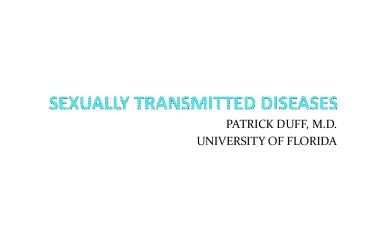SEXUALLY TRANSMITTED DISEASES - PowerPoint PPT Presentation
1 / 56
Title:
SEXUALLY TRANSMITTED DISEASES
Description:
Syphilis. LEARNING OBJECTIVES. Pathophysiology of infection. Clinical ... SYPHILIS. FREQUENCY. Incidence has increased , especially in females aged 15-24 years ... – PowerPoint PPT presentation
Number of Views:1447
Avg rating:3.0/5.0
Title: SEXUALLY TRANSMITTED DISEASES
1
SEXUALLY TRANSMITTED DISEASES
- PATRICK DUFF, M.D.
- UNIVERSITY OF FLORIDA
2
SEXUALLY TRANSMITTED DISEASES
- Chlamydia
- Gonorrhea
- Syphilis
3
LEARNING OBJECTIVES
- Pathophysiology of infection
- Clinical manifestations
- Diagnosis
- Treatment
4
KEY QUESTIONS
- Most practical, clinically useful diagnostic test
for gonorrhea and Chlamydia - Most appropriate antibiotic for treatment of
chlamydia endocervicitis - Characteristic lesions of each stage of syphilis
5
SEXUALLY TRANSMITTED DISEASESOVERVIEW
6
SEXUALLY TRANSMITTED DISEASESOVERVIEW
Esoterica
7
CHLAMYDIA
- Pathogen - Chlamydia trachomatis
- Obligate intracellular parasite
- Can be grown in tissue culture
8
CHLAMYDIA TRACHOMATIS
9
CHLAMYDIAMICROBIOLOGY
- Reticular body
- Elementary body infectious form
10
CHLAMYDIA MECHANISMS OF TRANSMISSION
- Sexual contact
- Perinatal
11
CHLAMYDIADISPELLING AN URBAN MYTH
12
CHLAMYDIAFrequency
- Most common STD in Western countries
- 3 - 5 x as common as gonorrhea
- Prevalence varies with the population
13
CHLAMYDIAMANIFESTATIONS IN MEN
- Urethritis
- Proctitis
- Epididymitis
14
CHLAMYDIAMANIFESTATIONS IN WOMEN
- Urethritis
- Endocervicitis
- Proctitis
- PID
- Perihepatitis
15
FITZ-HUGH-CURTIS SYNDROME
16
CHLAMYDIADIAGNOSIS
- Clinical examination
- Culture
- Nucleic acid probes - PCR
17
CHLAMYDIADIAGNOSIS
18
CHLAMYDIATREATMENT
- Patient and partner should be treated
- Drugs of choice
- Doxycycline
- Erythromycin
- AZITHROMYCIN
19
CHLAMYDIASEQUELAE
- Infertility
- Ectopic pregnancy
- Chronic pelvic pain
20
CHLAMYDIAUNUSUAL PRESENTATIONS
- Trachoma
- Inclusion conjunctivitis
- Lymphogranuloma venereum
21
TRACHOMA
22
INCLUSION CONJUNCTIVITS
23
LGVCLINICAL MANIFESTATIONS
24
GONORRHEAMICROBIOLOGY
- Pathogen Neissseria gonorrhoea
- Gram-negative diploccus
- Can be cultured in selective media
25
GONORRHEAMECHANISMS OF TRANSMISSION
- Sexual contact
- Perinatal
26
GONORRHEAFREQUENCY
- Less common than chlamydia
- Prevalence varies with population
27
GONORRHEAMANIFESTATIONS IN MEN
- Urethritis
- Epididymitis
- Proctitis
- Pharyngitis
28
GONORRHEACLINICAL PRESENTATION
29
GONORRHEAMANIFESTATIONS IN WOMEN
- Urethritis
- Endocervicitis
- Proctitis
- PID
- Pharyngitis
30
GONORRHEADISSEMINATED INFECTION
- Arthritis
- Dermatitis
- Pericarditis and endocarditis
- Meningitis
- Perihepatitis
31
DISSEMINATED GONORRHEACLINICAL PRESENTATION
32
GONORRHEADIAGNOSIS
- Clinical examination
- Gram stain
- Culture
- Nucleic acid probes
33
GONORRHEAGRAM STAIN
34
GONORRHEATREATMENT
- Patient and partner should be treated
- Drugs of choice
- Ceftriaxone 125 mg i.m.
- Quinolone concern with increasing resistance
35
GONORRHEASEQUELAE
- Infertility
- Ectopic pregnancy
- Chronic pelvic pain
36
GONORRHEASEQUELAE
37
GONORRHEASEQUELAE
38
SYPHILISMICROBIOLOGY
- Pathogen - Treponema pallidum
- Cannot be cultivated in vitro
39
SYPHILISFREQUENCY
- Incidence has increased , especially in females
aged 15-24 years - Highest prevalence - urban blacks and hispanics
40
SYPHILISMECHANISMS OF TRANSMISSION
- Sexual contact
- Perinatal
41
SYPHILISCLASSIFICATION
- Primary
- Secondary
- Latent
- Early
- Late
- Tertiary
42
CONGENITAL SYPHILISRISK OF PERINATAL TRANSMISSION
Stage of Disease
43
SYPHILISDIAGNOSIS
- Clinical examination
- Darkfield microscopy rarely used
- Serology mainstay of diagnosis
- VDRL or RPR screening test
- MHA or FTA confirmatory test
44
PRIMARY SYPHILISPRINCIPAL CLINICAL FINDING
45
SECONDARY SYPHILISPRINCIPAL CLINICAL FINDINGS
46
SECONDARY SYPHILISPRINCIPAL CLINICAL FINDINGS
47
LATE STAGE SYPHILISPRINCIPAL CLINICAL
MANIFESTATIONS
- Destructive gummas
- Aortic valve injury
- CNS manifestations
- Dementia
- Tabes dorsalis
- Pupillary abnormalities
48
ARGYLL-ROBERTSON PUPIL
Accommodates but does not react
49
LATE STAGE SYPHYLISGUMMAS
50
CONGENITAL SYPHILISCLINICAL MANIFESTATIONS
- Fetal death
- Growth restriction
- Multiple anomalies
- Immediately apparent at birth
- Delayed appearance
51
CONGENITAL SYPHILISABNORMAL DENTITION
52
CONGENITAL SYPHILISSABER SHINS
53
SYPHILISTREATMENT
- Patient and sexual partner(s) should be treated
- Antibiotic therapy
- Penicillin preferred in pregnancy
- Doxycycline
- Tetracycline
54
STDsCONCLUSIONS
55
KEY QUESTIONS
- Most clinically useful diagnostic test for
gonorrhea and Chlamydia - Most appropriate antibiotic for treatment of
Chlamydia endocervicitis - Characteristic lesion of each stage of syphilis
56
SUGGESTED READING
- CDC. 2006 guidelines for treatment of sexually
transmitted diseases. MMWR































